Here’s something terribly old-fashioned. It’s a three-bar electric fire. When all three bars on it is rated at 3 kW (3 kilowatts) but with only one bar, the middle one at the moment, its power is 1 kW.

I chose to check the power of the fire by using plug-in power meter. Here is the reading.

You can see it says 1061 W, that means 1061 Watts, just over 1000 watts, or just over 1 kW.
It is useful to know that a watt is a joule per second. If an appliance, like this electric fire, has a power of 1000 watts that’s exactly the same as saying that it has a power of 1000 joules per second. It means that every second the appliance takes 1000 joules of energy from the supply and, in this case, delivers it into the room, using it to raise the temperature of the room and make up for the heat loss.
Just for some fun, let’s calculate how many joules this electric fire takes from the supply in an hour.
The fire takes 1000 joules every second.
In 1 minute there are 60 seconds so this fire will 1000 x 60 = 60,000 joules.
In an hour there are 60 x 60 = 3600 seconds. So this fire will take 1000 x 3600 = 3,600,000 joules.
Here’s another way of working the numbers out. The power of the fire is 1 kW. When it’s on for an hour the energy it takes is 1 kilowatt x 3600 seconds = 3600 kilojoules. Yes, that 3600 kilojoules is the same as the 3,600,000 joules we have just calculated.
What we have done to calculate the energy supplied to our fire is multiply the power of the fire by the time for which it is on.
Energy = power x time. That’s a formula that is worth remembering.
There is another unit of energy, a convenient one, that we use when we want to measure energy. The unit is the kilowatt hour. Let’s use our new formula to calculate the energy drawn by our electric fire running for 1 hours.
Energy = power x time = 1 kilowatt x 1 hour = 1 kilowatt-hour, abbreviated to 1 kWh.
The kilowatt-hour, or kWh, is the standard unit for measuring electricity supplied. Indeed it is so standard that it is used for gas and sometimes other fuels as well. It is even often referred to as ‘the unit’.
At the time of writing, October 2020, energy from the electricity supply costs just under 15p per kilowatt hour and, to make numbers convenient, I’m going to use 15p as the price of a unit.
Our 1 kW electric fire uses 1 kWh of electricity every hour. And since electricity costs 15p per kWh, the fire costs 15p per hour to run.
What does it cost if it is on for a whole year.
In a day there are 24 hours. In a year there are 365 days. So there are 24 x 365 = 8760 hours in a year.
If our electric fire is on for a whole year,
Energy = power x time = 1 kilowatt x 8760 hours = 8750 kWh.
(If some of this is used to you, try saying the unit ‘kilowatt hours’ to get familiar with it.)
What’s the cost to run this fire for a year? Well each kWh of electricity costs 15p.
So 8760 kWh will cost 8760 kWh x 15 p/kWh = 131,400 p, which is £1314.
Quick trick for working out the cost for a year’s continuous use
Let’s just remind ourselves of where we have come to. A 1 kW fire, that’s a 1000 W fire, costs about £1300 to run all year. This can be used to provide us with a very useful figure to remember.
If a 1000 W electrical appliance costs £1300 to run for a whole year, a 1 W appliance costs £1.30 to run for a whole year. Remembering this fact is jolly convenient for calculating the cost of running all sorts of things that are on for a long time.
A modern middle-sized LED light bulb has a power of about 8 watts.
Remembering that a 1W appliance costs £1.30 to run all year, an 8 W led lamp costs 8 x £1.30 = £10.40 per year to run continuously. If it only runs for 3 hours, that’s an eighth of a day, then it costs £10.40/8 = £1.30 to run every day for 3 hours.
But an old-fashioned hot filament light bulb would need about 60 W for the same brightness. 60 W would cost 60 x £1.30 = £78 a year to run continuously, or £9.75 (£78/8) to run for 3 hours every day for a year (1/8 of a day).
How much does it cost to run our electric fire for an hour?
Just to remind ourselves, let’s calculate how much our 1 kW electric fire costs to run for 1 hour.
Energy = power x time = 1 kW x 1 h = 1 kWh. That’s pretty obvious but it’s worth remembering where it came from and how to check the calculation.
And, since energy from the electricity supply cost 15p/kWh, the electric fire costs 15p per hour to run.
Efficiency
This post is all about heating, so we are only going to consider heating appliances. It’s very easy to use electricity efficiently for heating. That electric fire is 100% efficient. That means that if it takes 100 joules in from the supply, it gives 100 joules out to the room. But gas heaters are less, sometimes a lot less, than 100% efficient.
The price of gas
Again at the time of writing, October 2020, gas prices are very low, less than 3p per kWh. That is in an economic climate in which much of the world is in lockdown and fossil fuel prices are really very cheap. A more realistic price long term price is nearer 5p per unit and I am going to use this as the figure for my calculations.
Gas fires
Gas fires are not nearly so efficient as electric fires as the following data will show. And, as we shall see, they are generally much less efficient when they are not on full output.

Here are the specifications for the above Flavel fire.
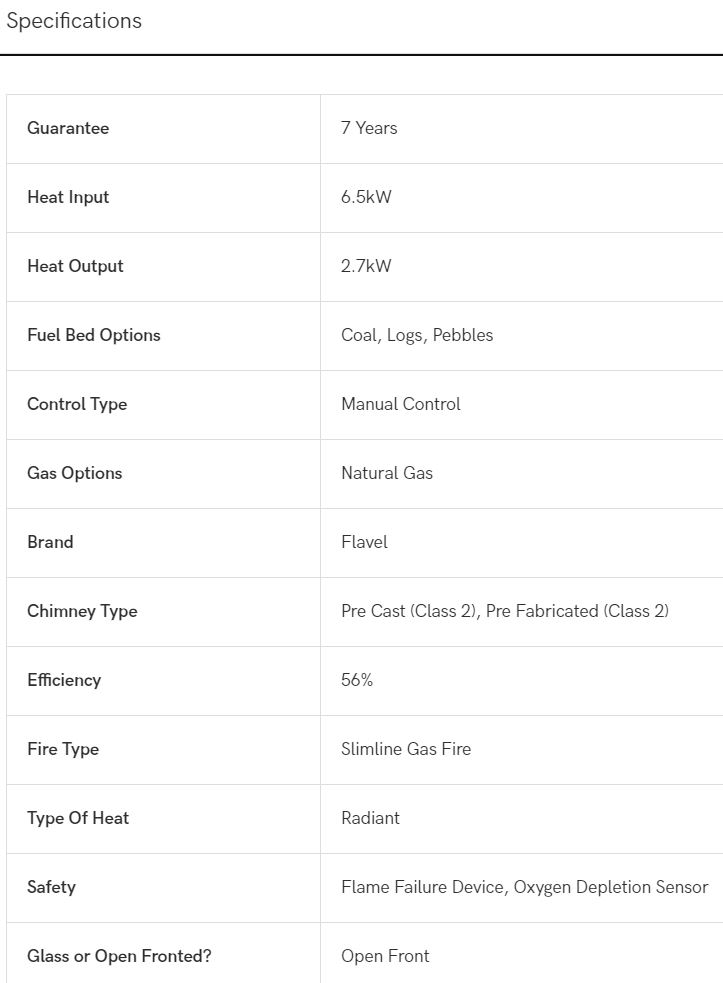
If your maths is quick, you might question have picked up something funny about these specifications. This fire gives 2.7 kW output for 6.5 kW input.
Efficiency = output/input = 2.7 kW/6.5 kW = 42%. This is much below the 56% that appears on the manufacturer’s specification. This is because manufacturers use what is called gross efficiency, a higher figure than the net efficiency we have calculated. This is explained later. For the moment we’ll run with the 42% efficiency.
If we turn this fire down a bit from 6.5 kW input, and if it has the same efficiency, (pretty unlikely because gas fires become much less efficient when used at low power), if the input is 2.4 kW, then the output is 2.4 kW x 42% = 1 kW. That’s the same figure as our electric fire. But to give out 1 kW heating the room the electric fire took in 1 kW. To give out 1 kW to heat the room, the gas fire needs 2.4 kW.
Where does the wasted energy of gas fires go?
If you’re a heating engineer, you’ll know the answer. For the average consumer it’s not so obvious what happens to the energy wasted by a gas fire. The answer is that it goes up the chimney and heats up the atmosphere. When your gas fire is on low, and taking 2.5 kW from the gas supply, 1 kW comes out into the room and 1.4 kW is wasted going up the chimney.
Hourly cost of a gas fire
On low, our gas fire takes in 2.4 kW from the gas supply (to give us 1 kW into our home).
Energy = power x time = 2.4 kW x 1 h = 2.4 kWh. Since gas costs 5 p/kWh, our gas fire costs 2.4 kWh x 5 p/kWh = 12p to run for an hour. Sure it’s a bit cheaper than an electric fire but not very much and, as we see later, gas fires are very inefficient at low powers and the real cost will be more than this.
More efficient gas fires
Here is a more efficient gas fire.
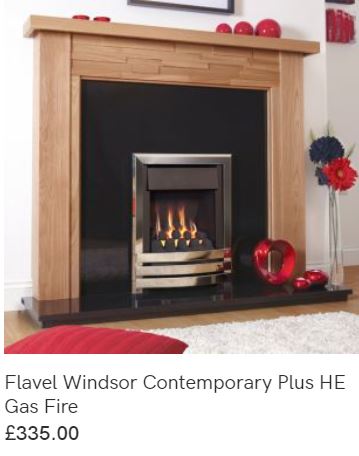
And here are its specifications:
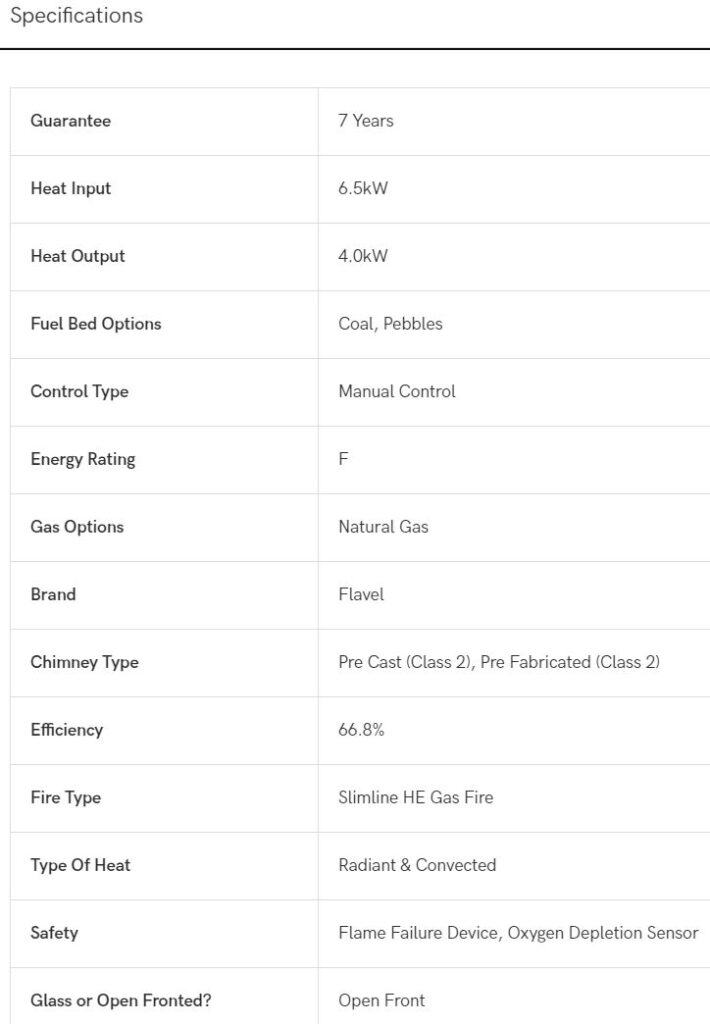
Let us again calculate its efficiency from the input and output figures.
Efficiency = output/input = 4.0 kW/6.5 kW = 62%. Again you can see that this is more than the specified 66.8%.
You can see that this fire gives out by both radiation and convection. The fire has a box around the hot bits which air from the room can circulate through and take more of the heat from the burning fuel leaving less to be wasted up the chimney.
Let’s see how much it costs per hour to match the electric fire.
For 1 kW output it needs 1.6 kW input.
Energy input = power x time = 1.6 kW x 1 hour = 1.6 kWh.
With gas costing 5 p/kWh, the cost per hour = 1.6 kWh x 5 p/kWh = 8p.
Even more efficient gas fires
Here is Flavel’s most efficient gas fire.
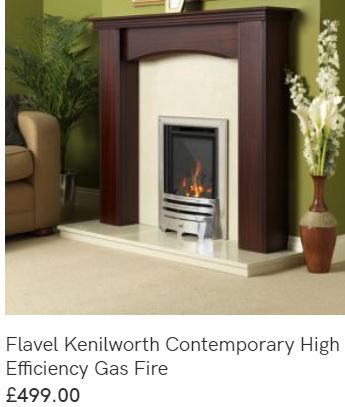
Again let’s look at its specifications:
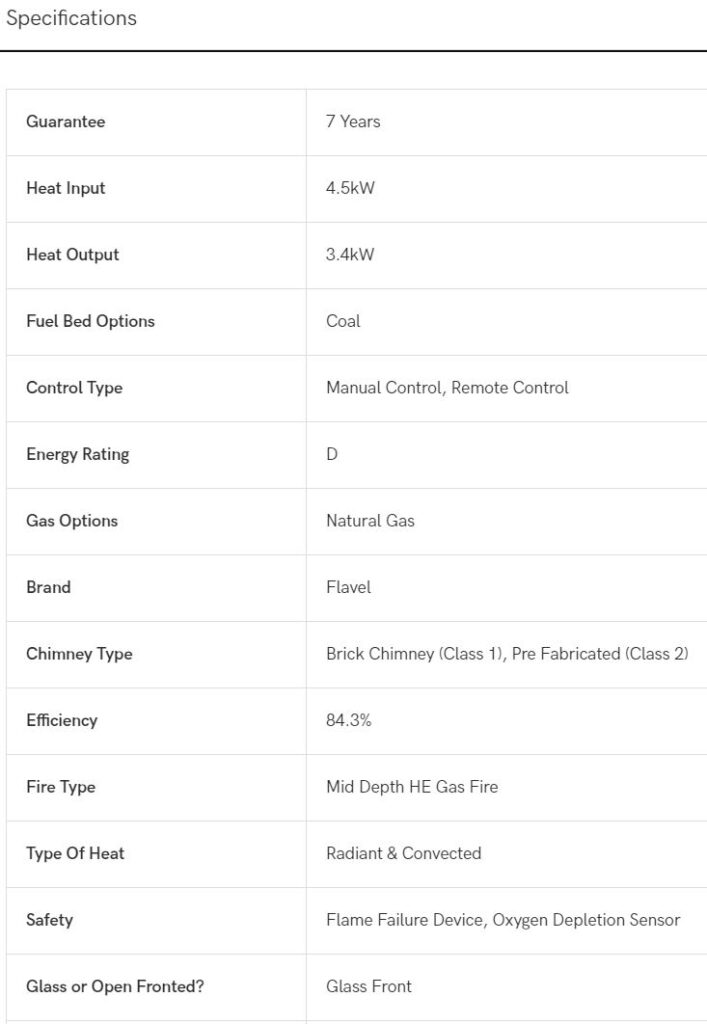
Calculating again the efficiency from the input and output figures,
Efficiency = output/input = 3.4 kW/4.5 kW = 76%, which is again below the 84% quoted by the manufacturer.
Again you can see that this fire heats the room by both radiation and convection. It has a box heat exchanger around it through which the room’s air flows, extracting more heat from the flame. But there’s another difference compared with the previous two fires. This fire has a glass front which restricts the amount of air going up the chimney. Excess air going up the chimney increases the losses to the atmosphere. The glass front massively removes this source of waste.
Let’s see how much it costs per hour to match the electric fire.
For 1 kW output it needs 1.3 kW input.
Energy input = power x time = 1.3 kW x 1 hour = 1.3 kWh.
With gas costing 5 p/kWh, the cost per hour = 1.3 kWh x 5 p/kWh = 6.5 p.
So an efficient gas fire would seem to cost less than half that of an electric fire for the same output.
Gas fires are very inefficient at low outputs
Here is detailed information about the Flavel Kenilworth High Efficiency fire discussed above.
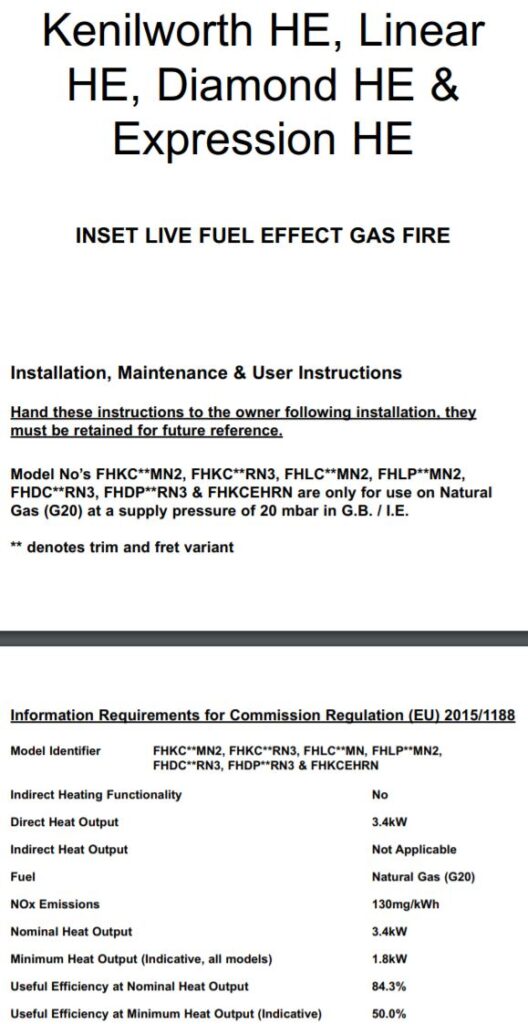
You can see that at minimum heat output the efficiency of this fire is only 50% at low outputs. That’s the manufacturer beneficial efficiency figure. The net efficiency (the real one we have been using) is therefore about 45%. So to get 1 kW out the fire will take in 2.2 kW. This will cost 11 p per hour to run, not very much less than the 15 p for the electric fire.
If you have an inefficient gas fire, like the first on our list, at low outputs its efficiency may well be only 33%. So to get 1 kW out it will need 3 kW in. Therefore its running costs will be 15p per hour, just the same as an electric fire.
Is the 5p per kWh figure for gas fair?
Historically gas prices have been over 4p per kWh and my guess is that they will return to these levels. Your guess, whatever it is, may well be better than mine.
Why are the quoted efficiencies of gas fires always more than our calculations?
You will not be surprised to hear that manufacturers put the best spin on their figures. They therefore use an efficiency figure that makes their fires look as efficient as possible. Over the last 30 years they have moved from what is called net efficiency to gross efficiency.
When gas is burned, water vapour is produced. Gross efficiency assumes that the energy contained in the water vapour cannot be recovered, whereas net efficiency assumes that it can be recovered. In fact we know from condensing boilers that it is possible to recover energy from the water vapour produced when gas is burned.
Have a look at the (planned to be next on the list) post about condensing boilers and efficiency for full calculations of efficiency when the water vapour is allowed to condense.